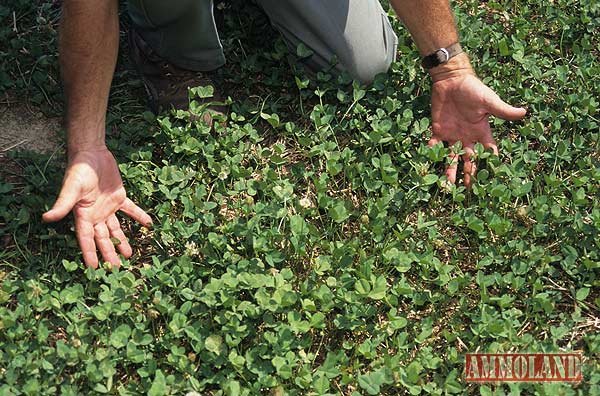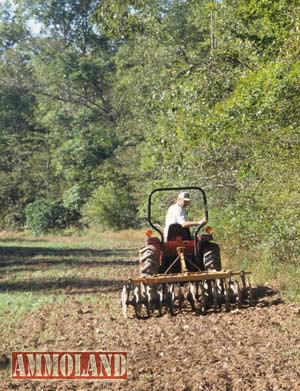
Food plots should offer deer nutritious food every month of the year.
Pottstown PA --(Ammoland.com)- “Why is it our farm does not seem to have as many deer especially bucks, on it as our neighbor’s farm?
The only difference in our management style is that our neighbors plant food plots, spring and fall and we plant food plots just in the fall.”This is one of the questions we get most often from not only Whitetail Unlimited members, but deer hunters in general. Quite frankly, it is one of the easiest deer management questions to answer. It is, in part, about having a dinner plate full, on a year around basis.
Holding deer, specifically bucks, on a year around basis requires a combination of habitat requirements. First is security. There must be areas where the deer feel safe. Bedding areas and escape routes are a must. Then comes water. Deer require surface water to be available all year. Next is diversity. They like diversity so there is a need for openings, dense brush, open woods and corridors offering cover. And last, but by far not least, comes food. Deer require a variety of food including young twigs, buds, and leaves of certain trees and shrubs. They like certain grasses, sedges, legumes, forbs, fruits and nuts. Their consumption of these food plants varies seasonally, based on when they are available. It is here that the food plot plays a role in helping create the ideal year round habitat, or falls short.
As long as there is an ample supply of good food in the food plots and all other factors are met, the deer, bucks and does, are likely to stay in an area. Take away a choice food supply and they may start to wander in search of a new food source.

Plant warm season food plot crops with the same planning and care given cool season crops.
As a wildlife manage, I have always found it easy to get hunting clubs and rural landowners to plant fall food plots as they are considered an attraction to bucks looking for choice food, a place to sit in a blind or stand and see deer. But the spring/summer food plots are not grown for hunting and they are more often than not considered of little value.
We all know that deer need all the help they can get in the way of food for the winter. A food shortage can be life threatening. We do not think, however, of the spring and summer as being a time of need, the woods and fields are green and wildlife appears to be healthy. In high quality habitat during years of ample rainfall and mild summer temperatures, this may be so; but these are becoming rare due, in part, to climate change.
The warm and hot months of summer are a stress period for deer and especially deer found in low quality habitat. Bucks are growing antlers. If food is insufficient, bucks will not develop antlers to their age and genetic potential. Does are pregnant, having fawns and producing milk. Fawns are growing and being weaned. The deer population is at its highest numbers. There is a sudden need for high quality food and lots of it. Now that some of the U.S. is suffering from higher summer temperatures, less rainfall, and drought or near drought conditions, much of the food available to deer is lower in moisture content than usual and often lower in quality. Deer are under stress and in the warmer parts of the country. The hot summer is the period of highest stress.
 Planning is a Must
Planning is a MustHigh quality year-round, cool season and warm season, food plots require planning to offer deer a dependable, highly nutritious food source on a 12 month basis. By now, most food plot growers know that in order to get top crop production on any food plot a soil test must be taken and the resulting recommendations for lime and fertilizer followed. Since most food plots are planted in annual crops for the fall and spring, it is necessary for the warm season crops to be listed on the soil test information sheet as well as the cool season crops. Far too many hunters list only the plants they are going to plant in the fall and omit the spring plants. To get healthy summer crops they must have the proper lime and fertilizer as well. This crop rotation information must be a part of the soil test.
Planning the crops to plant in your food plots for both cool and warm seasons requires some thought and advice from an agricultural expert with experience in the area where your land is available. Just selecting a highly advertised plant mix at a hardware store and scattering it in your food plots won’t produce the food source you want to keep the deer on your property happy. Each crop has certain requirements. Some do well on dry well drained sites while others do well in moist bottomland type soil. Some are hardy during low temperatures, while others do well under drought conditions. Some do well in the warm south, while others do best in the cooler north. Where there are high deer populations, you will want to select crops that can tolerate heavy grazing and keep coming back with new growth.
 Consider Perennial Crops
Consider Perennial CropsThere is a growing interest in planting food plots in green browse perennial plants. You plant this crop one time and, with management, it provides a green food plot on an almost year around basis for five years or more. Crops that fit this category include Durana clover, Ladino clover, Alsike clover, red clover and alfalfa. It sounds like a “magic bean” for food plots, but it isn’t quiet that. The advantages are obvious, plant it once in five years and you have wildlife food. However, it requires some effort. Like annual crops, it requires annual fertilization. It must be mowed to keep weed competition down during the warm months. It does not do well in all sites and regions, and, depending upon weather conditions, it can go through periods where there is little plant growth. Companies like Hunter’s Specialties, Pennington Seed and Whitetail Institute, however, continue working to prefect some of these perennials and they look very promising as long term food plot crops for some regions of the country.
Like the annual crops, the perennials must be selected with care, considering the soil and other conditions of your property.
Consult With County Agricultural Agent
One of the best sources of free advice for selecting both cool and warm season annuals and perennials is the local Cooperative Extension Service county agent. Almost every county in the U.S. has one. Ask at any farm supply store and they can tell you how to find him. Spend an hour with the county agent and you can plan your year around food plot crops and get free advice on soil testing, planting recommendations, and planting dates. Follow his recommendations and your food plots will reflect it. This may be the best free advice you will ever get!
One of the best sources of free advice for selecting both cool and warm season annuals and perennials is the local Cooperative Extension Service county agent. Almost every county in the U.S. has one. Ask at any farm supply store and they can tell you how to find him. Spend an hour with the county agent and you can plan your year around food plot crops and get free advice on soil testing, planting recommendations, and planting dates. Follow his recommendations and your food plots will reflect it. This may be the best free advice you will ever get!
 Plan Replanting
Plan ReplantingOn large properties with numerous food plots, the planting dates for planting annual crops can be crucial especially during the late summer plantings. All summer, the deer and other wildlife on your property have counted on the food being in the food plots. Then suddenly you come in and plow up the remaining food and replant a fall crop. This shock period can be reduced by planning your food plots so that it takes place gradually over a period of weeks. You want it so when the last food plots are being plowed up, the first ones plowed are coming back in green growth. The same thing needs to apply to the spring plantings. I never want all my food plots to be non-productive at the same time.
Keep Records
Having worked with food plots for over 40 years I have learned that food plots have their own personalities and you can learn how to get the most out of a food plot by keeping annual records on it. Such facts as how much lime and fertilizer is applied and the date applied need to be recorded as well as when it was plowed and when it was planted, what was the crop and seeding rate? How many bucks/does do hunters see on the plot and the dates? Rain dates and amounts are important. Deer and turkey taken on a food plot, their size and date taken is valuable. Reviewing records such as this, especially over a period of years, allows the manager to see what works best on a specific plot and what changes may be necessary to make it more productive. The more available highly nutritious food that is available on a food plot, year around, the more likely it is going to be in holding those bucks you want to see.
Having worked with food plots for over 40 years I have learned that food plots have their own personalities and you can learn how to get the most out of a food plot by keeping annual records on it. Such facts as how much lime and fertilizer is applied and the date applied need to be recorded as well as when it was plowed and when it was planted, what was the crop and seeding rate? How many bucks/does do hunters see on the plot and the dates? Rain dates and amounts are important. Deer and turkey taken on a food plot, their size and date taken is valuable. Reviewing records such as this, especially over a period of years, allows the manager to see what works best on a specific plot and what changes may be necessary to make it more productive. The more available highly nutritious food that is available on a food plot, year around, the more likely it is going to be in holding those bucks you want to see.
 Year around food plots alone are not going to guarantee that your property will attract and hold mature bucks, but when it is a part of a totally managed habitat, you put the odds in your favor.
Year around food plots alone are not going to guarantee that your property will attract and hold mature bucks, but when it is a part of a totally managed habitat, you put the odds in your favor.FOOD PLOT CROPS
Annual Cool Season
- Wheat
- Rye
- Corn
- Chicory
- Ryegrass
- Oats
- Crimson Clover
Perennial
- Durana Clover
- Ladino Clover
- Alfalfa
- Alsike Clover
- Red Clover
- Orchard Grass
- Redland Ii Clover
Annual Warm Season
- Cowpeas
- Soybeans
- Sunflower
- American Jointvetch
- Alyceclover
- Buckwheat
- Lablab
By J. Wayne Fears
No comments:
Post a Comment